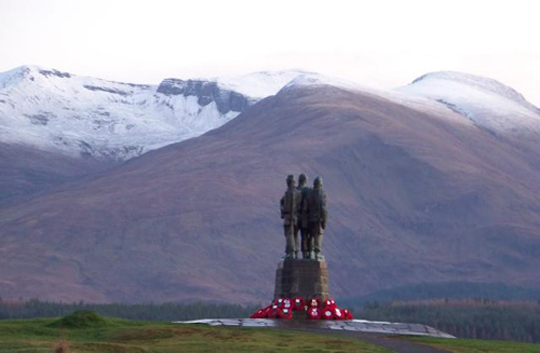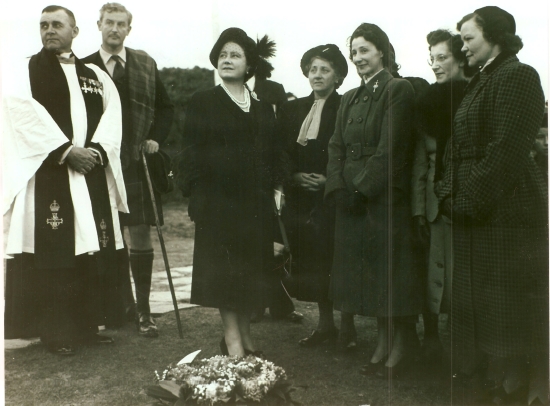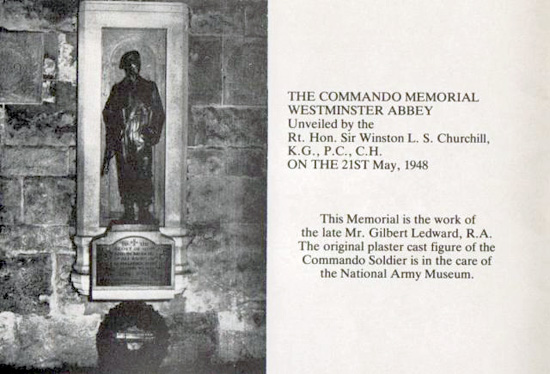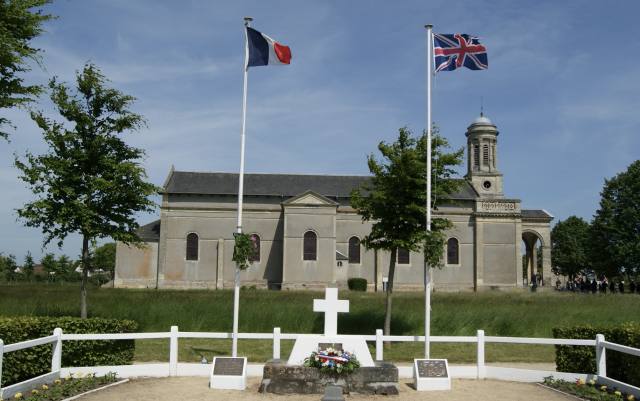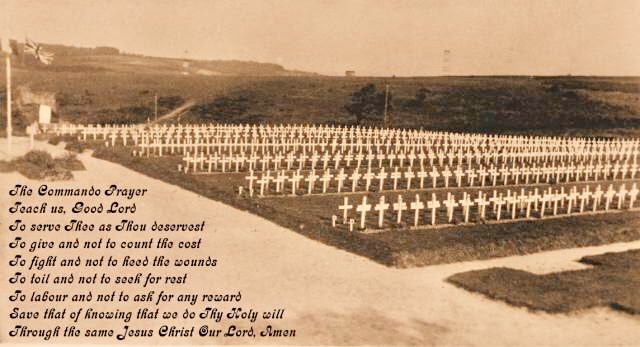
Cemeteries and War Memorials
This is a list of countries where we know that a Commando who died in service between 1940 and the present day is buried or remembered, including the respective cemeteries or memorials within those countries.
"When You Go Home, Tell Them Of Us, And Say,
For Your Tomorrow, We Gave Our Today."
[Notes]
Click or touch any cemetery name to view those Commandos who are remembered there.
Press Ctrl and 'F' then type the first name of the cemetery or memorial, then send, and those will be highlighted.
Aden (Yemen)
America
Belgium
Channel Islands
Czech Republic
Egypt
Eritrea
Falkland Islands
France
Germany
Greece
Holland
Italy
Korea
Libya
Madagascar
Malta
Nepal
Norway
Republic of Ireland
Singapore
South Africa
Sri Lanka
Sudan
Tunisia
Turkey
Uganda
United Kingdom - England
United Kingdom - Northern Ireland
United Kingdom - Scotland
United Kingdom - Wales
Memorials to Commandos
The Commando Memorial
Douglas Percy Bliss MA, ARCA - Principal of the Glasgow School of Art,
Dr Tom Honeyman JP - Glasgow’s Director of Art Galleries and Museums,
Sir John Richmond KBE, LL.D – one of Glasgow’s leading authorities on Art,
Sir William Reid Dick KCVO, RA – Noted Sculptor.

Guidelines on plaques and scattering of ashes at the Commando Memorial
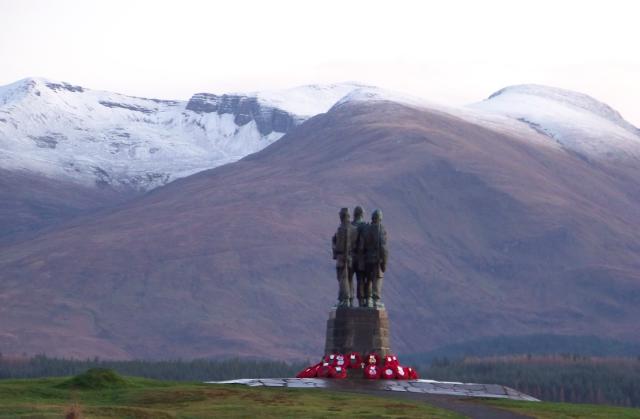
Community Services
Carr’s Corner Depot
Lochybridge
Fort William
PH33 6T
Phone: 01397 709000
email [email protected]
Chief Executive’s Office
Fort William
Phone: 01397 707231
50th anniversary of the unveiling of the Commando Memorial, Spean Bridge.
A beautifully produced Service of Remembrance booklet to Commemorate the 50th Anniversary of the unveiling of the Commando Memorial at Spean Bridge by HM Queen Elizabeth the Queen Mother. The memorial was unveiled and dedicated on the 27th September 1952. The anniversary commemoration took place during Remembrance weekend on the 9th November 2002.
This Service of Remembrance was attended by HRH Prince Phillip, The Duke of Edinburgh, K.G., K.T.
The booklet contains the history of the Memorial in photographs and narrative and a lot of other information about the Commandos.
Army Commando Memorial
Photo: John Mewett, Tim McKerrith, Frank Johnson (3Cdo), Fran McKerrith, Norris Pickford, Capt. Geoff Murray - the concept design and installation team of the Memorial.
History of the Army Commando Memorial
Written by associate member John Mewett. Note: The 'Commando Veterans Association' reverted to the title of the original 'Commando Association' in 2019 after this report was written. The Commando Veterans Association Memorial to the Army Commandos at the National Memorial Arboretum, Alrewas, was unveiled by HRH Prince Phillip on 29th July 2007.The idea for this installation was first discussed at the Lincoln Branch of the newly formed Commando Veteran Association in December 2005 and a motion passed and subsequently put formally to the National Committee CVA on 10th January 2006.
The founder of the CVA Vic Ralph (1 Cdo), Deputy Chairman Lincoln Branch Frank Johnson (3 Cdo), and secretary of the Lincoln Branch John Mewett were then tasked by Stan Scott (Chairman) and the CVA National Committee, with bringing the project into being.
The National Arboretum was visited on a cold snowy February morning and it was agreed unanimously that the CVA must have a presence there for the future.
Engineer designer Norris Pickford was drafted into the team, Norris agreed to donate his time and services free to the project, he had designed similar works before and had long experience on working with metals and structures of the type envisaged.
Many sessions were held with quite a few different designs being considered. A scaled down replica of the Spean Bridge monument was even spoken about and priced but it proved to be too difficult to realise. The final design as it is seen to today was decided upon because of the iconic status that the FS Commando Knife holds among all who have worn the Green Beret and it also provided a continuity link with the old ‘Commando Association’ who had used a similar design in the past, but had by this time stood down. Read about the origins of the fighting knife here: History of the Commando Fighting Knife.
A drawing was completed and appointments were made to discuss the project with Paul Kennedy, grounds manager of the National Memorial Arboretum.
Norris prepared a life size model of the proposed memorial centre piece from paper and card. On Paul enquiring ‘what do you have in mind’ Norris laid out the replica on the manager’s office floor. ‘That’s it ‘he said ‘life size’. A small silence followed. ‘Great I’ll put the wheels in motion’ came Paul’s reply.
Anwick Forge in Lincoln was selected to create and assemble the centre piece and the team visited and explained the project to the talented and eager proprietors Tim and Fran McKerrith It was explained how important and revered the FS Knife, which formed the visual impact of the memorial, was to the soldiers of the commandos. Tim asked if an example was available and John offered his fathers (Bob Mewett’s No 12 & 1 Cdo) 1st pattern knife as a working model. Tim and Fran set to work.
The FS and wreath centre piece comprises of the mirror-polished forged stainless steel FS Knife up scaled 4:1 to within 1/1000 of an inch, a replica of the original 1st pattern FS Commando knife. This four foot knife is surrounded by a wreath of 126 individually hot-forged copper leaves, thus reflecting the badge worn by all service personnel who pass the qualification to wear the famous Green Beret and also the wreath as worn by the former association’s members.
The blade of the four foot long FS knife was forged under a 10 cwt power hammer from a single piece of stainless steel weighing approximately 25kg, which was heated to a temperature of approximately 1100 degrees in a gas furnace. The blade only, itself, took over four hours to complete! Blacksmith Tim McKerrith of Anwick Forge crafting the memorials FS Knife blade
 Blacksmith Tim McKerrith of Anwick Forge crafting the memorials FS Knife blade
Blacksmith Tim McKerrith of Anwick Forge crafting the memorials FS Knife blade
After some research copper was chosen as the metal for the leaves of the wreath as copper naturally weathers to a green colour thus slowly producing an appropriately green colour wreath. A truly fitting and ‘living’ memorial. This structure proudly stands on a steel centre pole encircled by the word ‘Commando’ visible from both sides of the memorial. The letters of the words are again in copper and the font was kept bold and large symbolising the fortitude and strength of the Commando forces. Frank, John and Norris visited the Anwick Forge several more times and on a couple of occasions actually helping with the fabrication of the memorial as the installation day drew nearer. By this time Capt. (later Major) Geoff Murray had been elected as the new Secretary of the CVA and he took over the wheels of organisation. Capt. Murray arranged for a team of young soldiers to construct the initial brickworks and labbing and he also administered the final details for the unveiling ceremony including arranging for the attendance of HRH Prince Phillip and the overall culmination of the project.
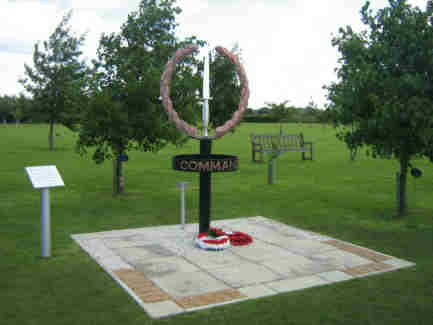 On that memorable day of 29th July 2007 the unveiling ceremony took place to an enthusiastic reception and the memorial has been a place of pilgrimage ever since.
On that memorable day of 29th July 2007 the unveiling ceremony took place to an enthusiastic reception and the memorial has been a place of pilgrimage ever since.
The CVA Army Commando memorial is close to the Royal Marines memorial. Unlike today, in WW2 not all Royal Marines were Commando trained.
The two memorials now honour all who served as Commandos, both Army and Royal Marines.
The initial installation has now evolved and includes seats, memorial paver blocks and in June 2013 the fabulous Walls of Honour were added which form a fitting backdrop to the beautiful FS Knife.
The Walls of Honour carry the names of all the Army Commandos who lost their life whilst in Commando service during the Second World War. Anwick Forge were delighted to be asked to fabricate these to add to their initial work.
Commandos, Armed service’s personnel and families from all over the world visit the NMA and the CVA memorial stands out proudly to represent the bravery and service of all who have earned the right to wear the coveted Green Beret. The CVA summer gathering is held annually at the memorial in July. Details of this can be found on our events page.
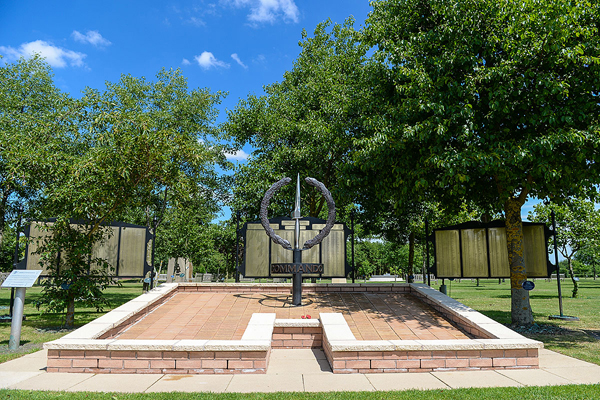
The Memorial in 2015
Westminster Abbey Memorial
The Combined Services Memorial at Westminster Abbey was unveiled on the 21st May 1948 by the Right Honourable Sir Winston Churchill KG PC.
It was designed by the sculptor Gilbert Ledward, with three bronze figures in stone niches, with the dates 1939 and 1945 on tablets between. The models for the figures were serving members of the forces – the submariner was modelled on Leading Seaman Reginald Read, the Commando on Company Sergeant Major Ayres, and the representative of the Parachute Regiment was Corporal Howard Elliott.
A Roll of Honour for Commandos is on display in a case in the nave of the Abbey and the Commando Association Battle Honours flag is framed and displayed on the wall in St George’s chapel. The Roll was pesented to the Abbey in 1949 by officers of the Commando Depot and completed though the generosity of Brigadier R.J.F.Tod.
A thanksgiving service with dedication of the Battle Honours Flag took place on the 15th April 1961.
The Laying Up of the Flag, unveiled by The Queen Mother, was on the 1st May 1971 (unfortunately the dagger at the top of this frame was stolen many years ago.)
Source: Westminster Abbey
15th April 1961 Dedication of the Commando Association Battle Honours Flag at Westminster Abbey. Narrated by Henry Brown OBE.
Westminster Abbey wreath laying
The Westminster Abbey Memorial models
Extract from the Dundee Evening Telegraph - Saturday 17 August 1946
Mr Gilbert Ledward, R.A., picked a real commando for his model for a bronze figure he is sculpting for the commando memorial in Westminster Abbey. The model was Company Sergeant Major Ayres, who was in several raids on the Norwegian coast *.
Mr Ledward is now finishing the clay model for a second figure, that of a parachutist. Model for this is 23-year-old Corporal H. Elliott, who wears the famous red beret when is walking out. In full parachutist's equipment and carrying a sten gun, he poses for five or six hours every day at Mr Ledward's studio. He finds it a little tiring, but nothing at all compared with the crossing of the Rhine, in which took part.
The third figure will represent a sailor in the submarine service. Mr Ledward has not yet started work on this, and the model has not been chosen.
The three figures will commemorate men who volunteered for some of the war's toughest assignments. Sculptor Ledward, a gunner in World War I, has been at work since Christmas on the volunteers' memorial which will stand in the Abbey cloisters. Each of the figures will about three feet high, and Mr. Ledward has designed limestone setting for them to blend with the cloister walls. He does not expect to finish the memorial until next year. The clay modelling for each figure takes from three to four months, and the casting in bronze also a long job.
Sources Dundee Evening Telegraph British Newspaper Archive (website britishnewspaperarchive.co.uk); The British Library Board. * There was an SQMS R.B. Ayres BEM, who served in 12 Commando and 4 Commando BrigadeCHURCHILL, Winston speech at the unveiling of the Abbey Memorial
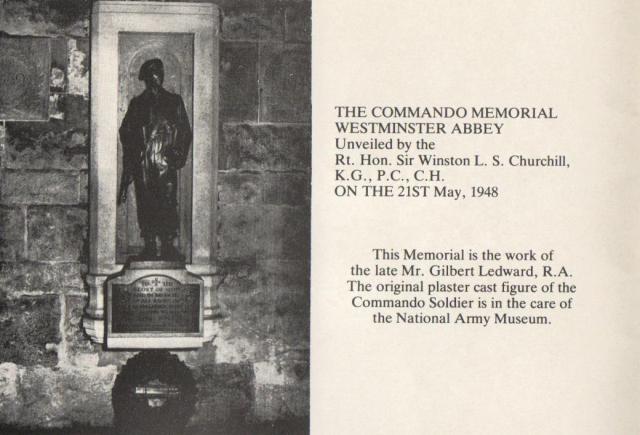
1st Special Service Brigade Memorial
1st Special Service (Commando) Brigade Memorial at Amfreville, France. Designed by Private Thomas Cyril Sharpe, 1 Special Service Brigade HQ, Intelligence Section. Image credit: Stephane Sant-Martin.
The Gibraltar Stone Memorial
Memorial to Commando Training
Woodbury Common nr Exeter
Ordinance Survey Maps can be found here: Maps of the area

Key Points
- The Gibraltar Stone is a new memorial commemorating commando training in Devon - Royal Marines, Army and All Arms Commandos have trained on Woodbury Common near Exeter since 1940.
- The stone is an actual piece of the Rock of Gibraltar, donated to the Royal Marines by the people of Gibraltar in 2014. This donation marked both the 350th anniversary of the creation of the Royal Marines in 1664, and the 300th anniversary of the capture of Gibraltar by British and Dutch Marines in 1704.
- The Memorial is located in the heart of Woodbury Common, on land owned by Clinton Devon Estates; it can be visited by the public.
- The Memorial is on the ridge between Peter’s Pool and the Water Tunnel (GR038859), overlooking the old World War II firing range and part of the ‘Endurance Course’.
- The stone carries on it two plaques. One commemorates the history of commando training on Woodbury Common, the second has on it the 4 key attributes that together make up ‘Commando Spirit’:
Courage – Determination - Unselfishness - Cheerfulness in Adversity

History of The Gibraltar Stone Commando Memorial
Early in 2014, the year of the 350th Birthday of the Royal Marines, it occurred to me that there was no memorial on Woodbury Common to mark the fact that thousands of Royal Marines, Royal Marines Commandos, Army Commandos and All Arms Commandos have trained there since 1940. Surely all the men – and now a few women - who have trained there and served their Country so well, and the great support they have received from the local population, deserved some mark of recognition?
By happy coincidence, in 2014, an ex-Commandant General of the Royal Marines, Lieutenant General Sir James Dutton KCB CBE, was serving as Governor of Gibraltar. Once he had been made aware of the idea, Jim Dutton approached the Chief Minister of Gibraltar, the Hon Fabian Picardo QC, with a request for a donation of stone for the memorial. The Royal Marines have a very close historical connection with Gibraltar, having captured it in August 1704. So General Dutton’s request also marked the 310thanniversary of that battle.
On behalf of the people of Gibraltar, the Gibraltar Government generously gifted to the Royal Marines an actual piece of the Rock of Gibraltar. As Chief Minister Picardo said: “Gibraltarians don’t part with pieces of their Rock lightly, but, if there is anywhere that we think there should be a piece of the Rock, it is close to the Royal Marines”
Weighing in at just over 4 tonnes, and approximately 1.5 metres in height, width and depth, this boulder had, some years previously, fallen from the cliffs of the Rock of Gibraltar above Catalan Bay. Its natural, pyramidal shape mirrored that of the Rock itself, and the white colour of its limestone provided the ideal background for bronze plaques.
With the help of members of the Gibraltar Regiment and Gibraltarian Environment Agency, the stone was collected and handed over to Royal Air Force movement staff in Gibraltar. They were able to put it on one of the C130 Hercules training flights which regularly visit Gibraltar, and it was delivered by them to RAF Brize Norton in the Oxfordshire.
In the meantime, Clinton Devon Estates, the landowners of Woodbury Common, had been approached to see if they would provide a site for the stone on the Common. In recognition of their long-standing relationship with the Royal Marines, and with strong personal support from the current Lord Clinton, outline permission was readily given. At the same time it was clear that environmental concerns would need to be addressed. Woodbury Common is a designated SSSI (Site of Special Scientific Interest) providing habitat for important endangered species such as the nightjar, southern damsel fly and Dartford warbler. Dr Sam Bridgewater, the Nature Conservation Officer at Clinton Devon Estates, worked with the project to provide the necessary environmental impact survey and to get approval for the siting of the stone from Natural England, the regulatory authority.
The stone itself had meanwhile been moved to South Wales where Mossfords, a firm of stonemasons specialising in war memorial restoration, had agreed to design, source and mount the bronze plaques at ‘cost price’ – an extremely generous offer of support for the Royal Marines. Working with the CEO of Mossfords, Simon Morgan, and the RSM from the Commando Training Centre Royal Marines, WO1 Phil Gilby RM, we designed and ‘word-smithed’ two plaques for the stone.
The first plaque describes the purpose of the memorial and what can be seen from its location. The view from the chosen site (Grid Ref SY038859) takes in both land and sea, reflecting the Corps’ motto: ‘Per Mare, Per Terram’. It also looks over some of the abandoned WW2 training facilities, notably an old rifle range and, in the trees beyond, the area once covered by Dalditch Camp. On the hillside immediately below the memorial the modern day Endurance Course passes close by. This six mile endurance challenge runs across the Common through tunnels and other obstacles. It has to be completed against the clock by anyone wishing to qualify as a commando and gain the coveted green beret. From the memorial one can see two of the Endurance Course obstacles: Peters Pool and the Water Tunnel.
The second plaque has on it the Royal Marines Crest, the Globe and Laurel, surrounded by the four key attributes expected to be displayed by a commando: Determination, Courage, Unselfishness, Cheerfulness in Adversity. These four qualities are the glue that binds commandos together, giving them their unique ethos or ‘commando spirit’. This smaller plaque faces one of the hills on the Endurance Course and it will be seen by every recruit and officer under training as they complete that part of their commando course.
By the end of 2014 the stone had been finished by the stonemasons in Wales and was moved to the Commando Training Centre Royal Marines (CTCRM) at Lympstone in Devon. CTCRM is the modern day centre of excellence for all Royal Marines and other arms commando training. It occupies the same site as the original RM Depot camp, built in 1939 for this purpose on the side of the River Exe estuary between Exton and Lympstone. CTCRM will act as custodians of the stone on behalf of the wider Corps of Royal Marines. In February 2015 CTCRM moved the stone to its new location on Woodbury Common. The challenge of moving and placing the stone in its new home was undertaken by Royal Marines Assault Engineers from CTCRM, with vehicle and logistics support provided by the Commando Logistic Regiment.
Funding for the project was provided by the Royal Marines Charitable Trust Fund, the charity which aims to improve the quality of life of serving and retired member of the Corps and their families. Many people have wished to donate to the RMCTF in order to support this memorial, and the work they do helping Servicemen during and after active duty. In order to do this, you can find details of the Charity’s work and links to making a donation on their website: http://www.rmctf.org.uk
In the longer term, the memorial will be looked after and maintained by the Commando Training Centre Royal Marines. All enquiries may be directed to them at 01392 414011.
Lt Col Alastair Rogers RM (Retd)
January 2015
** Ordinance Survey Maps can be found here: Maps of the area

